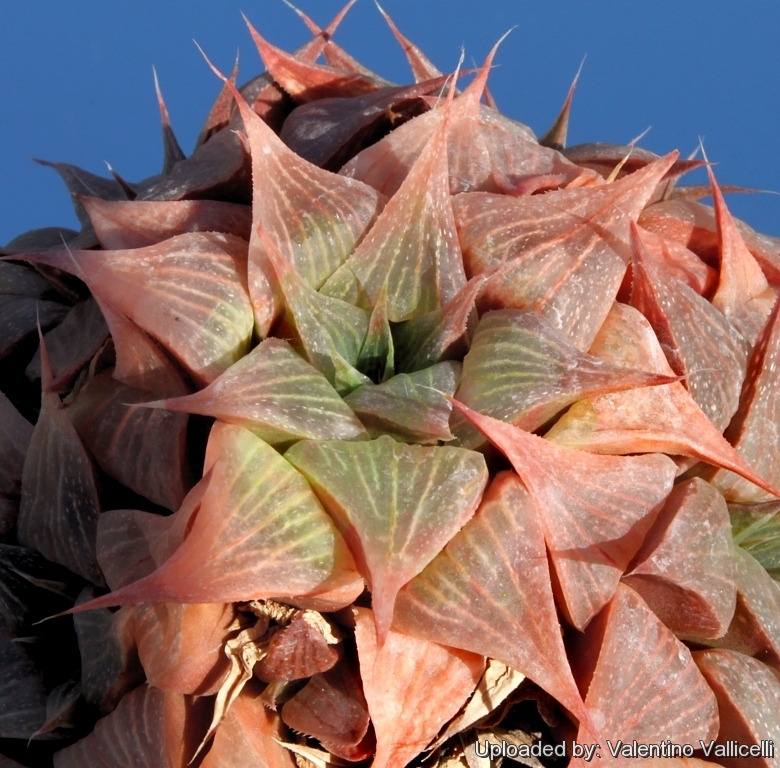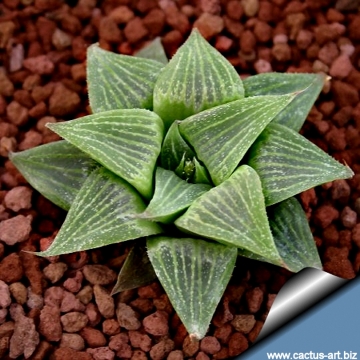
Haworthia magnifica var. acuminata Photo by: Valentino Vallicelli
North of Gouritmond TL (JVD87 92 PE0432)
Origin and Habitat: Southern Cape near the Gouritz River, South Africa.
Habitat: It grows in conglomerate soil, in a winter rainfall area in full sun or shade. The colour of the sand approximates that of the upper surface of the brownish-greenish leaves, and these are practically level with the soil and serve to camouflage this plant on the ground. This way Haworthia magnificaSN|13271]]SN|13271]] var. acuminata resist attacks from herbivorous predators, and is almost impossible to distinguish from its surroundings.
Synonyms:
See all synonyms of Haworthia magnifica
Description: Haworthia magnificaSN|16682]]SN|13271]] var. acuminata is one of the innumerable local form of the very variable Haworthia magnificaSN|13271]]SN|13271]]). It distinguishes for the leaves that are longer with a stiff truncate end-area. It is frequently found in cultivation labelled as Haworthia retusaSN|16708]]SN|16708]] var. densiflora, Haworthia magnificaSN|13271]]SN|13271]] or Haworthia paradoxaSN|13271]]SN|16682]].
Habit: It is a stemless solitary to slowly proliferous evergreen leaf-succulent species.
Rosettes: Up to 8 cm in diameter, dense, dark green to purplish.
Leaves: Up to 5 cm long, firm, triangular-elliptic tapering to a long terminal bristle (acuminate), dark green, brownish-green to purplish, end-area triangular slightly roughened, striated with 4 or 5 pale brown or greyish veins along the upper surfaces. End-area slightly translucent between the veins. Leaf margin rough with small whitish teeth along the edges and keel
Inflorescences: Produces a slender inflorescence up to 40 cm tall. Only few flowers open together at the same time.
Flowers: Small with green lines and a green throat. H. magnifica is characteristic for its short green lined buds and flowers and "fish-tail" bud tips.
Blooming season: Autumn.
Bibliography: Major references and further lectures
1) M. B. Bayer “The new Haworthia handbook” National Botanic Gardens of South Africa, 1982
2) John Pilbeam “Haworthia and Astroloba: A Collector's Guide” 1983
3) Stuart Max Walters, James Cullen “The European Garden Flora: Pteridophyta, Gymnospermae, Angiospermae” Cambridge University Press, 1986
4) Gibbs Russell, G. E., W. G. Welman, E. Reitief, K. L. Immelman, G. Germishuizen, B. J. Pienaar, M. v. Wyk & A. Nicholas. "List of species of southern African plants.” Mem. Bot. Surv. S. Africa 1987
5) Ernst Van Jaarsveld, Ben-Erik Van Wyk, Gideon Smith “Succulents of South Africa: A Guide to the Regional Diversity” Tafelberg Publishers, Limited, 01/lug/2000
 Haworthia magnifica var. acuminata Photo by: Valentino Vallicelli
Haworthia magnifica var. acuminata Photo by: Valentino Vallicelli Haworthia magnifica var. acuminata Photo by: Cactus Art
Haworthia magnifica var. acuminata Photo by: Cactus ArtCultivation and Propagation: Haworthia magnifica var. acuminata are of easy cultivation and relatively low maintenance, which makes them a good houseplant, and can be excellent subjects for the beginning succulentophile (they can grow easily on window sills, verandas and in miniature succulent gardens where they are happy to share their habitat with other smaller succulent plants, or in outdoor rockeries).
Growth rate: They are relatively slow-growing plants that offsets to form small clusters with time.
Soil: They are tolerant of a wide range of soils and habitats, but prefer a very porous potting mix to increase drainage. A non-acid soil is ideal. You can grow a plant in a 10-15 cm pot for years and have perfectly happy plants. For best results, use a shallow pot.
Exposition: The plant needs light shade to shade, but will take full sun part of the day. (with some sun exposure the leaf develops a nice reddish tint and remains compact)
Watering: During the hot summer months, the soil should be kept moist but not overly wet. During the winter months, water only when the soil becomes completely dry. Wet soil quickly causes root and stem rot, especially during chilly winter months. No water should ever be allowed to stand around the roots. Low ambient humidity is always needed.
Fertilization: The plants are fertilized only once during the growing season with a balanced fertilizer diluted to ½ the recommended strength.
Hardiness: Although the plant will survive mild frost if kept dry (hardy as low as -5° C) it should be protected from severe cold and prolonged frost conditions.
Rot: Rot is only a minor problem with Haworthia if the plants are watered and “aired” correctly. If they are not, fungicides won't help all that much. Care must be given in watering, keeping them warm and wet while growing, and cooler and dry when dormant.
Remarks: Haworthias are best planted in a shaded and airy part of the greenhouse, and not too close to the glass roof or sides of the house as the plants can overheat during hot spells.
Propagation: Haworthia are easily propagated by the removal of offshoots or by leaf cuttings in spring or summer. To propagate by leaf cuttings, remove a leaf and let it lie for about one month, giving the wound time to heal. Then lay the leaf on its side with the basal part buried in the soil. This leaf should root within a month or two, and small plants will form at the leaf base. They can also be grown from seed.












